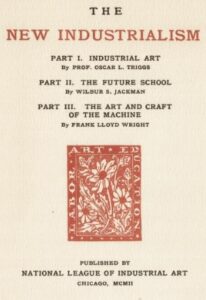As technology and the tools derived from that technology change over time (hopefully in the direction of progress), our handiwork should adapt. Expressions and results that we believed impossible or impractical may become achievable or even common place in the near future. Examination of that adaptation, or lack of adaptation, in the last century demonstrates that artistic progress is not certain and technical advancement is no assurance of pleasing aesthetic/artistic outcomes.

In 1901 Frank Lloyd Wright delivered an address entitled, “The Art and Craft of the Machine.”[1] That speech contained the following passages:
“We will find the magnificent prowess of the machine bombarding civilization with mangled corpses or strenuous horrors that once stood for cultivated luxury and are now a species of commercial vulgarity. Without regard to first principles or common sense the letter of tradition is recklessly fed into the rapacious maw of machines until “reproductions” may be had for ninety-nine cents where the original cost ages of toil and patient culture. This seems like progress were it not that these very things are now harmful parasites befogging the sensibilities of our natures, belittling and falsifying any true perception of normal beauty the Creator may have seen fit to implant in us. The idea of fitness to purpose, harmony between form and use is lacking in them as t it is sadly lacking in us; and as for making the best of the conditions which produce them, by so doing idealizing the industrial fabric that is perverted and enslaved by them, the mere idea has grown abnormal. …
… As perhaps wood is the most available of homely materials and naturally then the most abused, let us first glance at wood.
Machinery has been invented for no other purpose than to imitate the woodcarving of the early ideal, with the result that no cheap furniture is salable without some horrible botch work meaning nothing unless it means that “art and craft” has fixed in the minds of the masses the old hand-carved chairs as the “ne plus ultra” of the ideal. … Simplicity teaches us that the beauty of wood lies in its qualities as wood. Treatments that fail to bring those qualities foremost are not plastic, therefore not appropriate – so not beautiful. The machine teaches us, if we have left it to the machine, that certain simple forms and handling serve to bring out the beauty of wood and retain its character and that certain other forms and handling do not … The machines used in this work will, if a little study is bestowed upon them, show you that by unlimited cutting, shaping, smoothing, and repetitive capacity they have emancipated these beauties of nature in wood … Here these machines considered technically have placed in the hands of the designer a means of idealizing the true nature of wood harmoniously with man’s spiritual and material needs without waste and within the reach of everyone. But an unfair advantage is taken of peerless tools and we merely suffer from a riot of vitiated handicraft. …
You will find in studying the group of old materials that they have all been rendered plastic by the machine. The machine itself is steadily creating the very quality in these things needed to satisfy its own art equation. …“
Wright, as we do now, saw the ‘dumbing down’ of artistic products through undisciplined, unscrupulous and unimaginative uses of new machine-age tools. But, more importantly, he simultaneously notices what industrialization made possible with the use of recent technology. Wright gave examples of craft results not previously imagined. The tone of his presentation implies that Wright was attempting to persuade his audience that the potential of new, industrial tools to contribute to novel artistic possibilities was worth the risk they represented to future art & craft.
Unfortunately, the intervening years have not been kind to Wright’s fragile, hoped for enhancing application(s) of industrialization. Junk has proliferated. Realizations of art & craft literacy, not so much – thus, the reason “we don’t have nice things.” However, Frugal e•Mart believes that there is always a chance for redemption.
The surge in grass-roots craft activity during and following the pandemic is an opportunity to surface the potential of modern tools in a manner that the mass market (a would-be Design Hero – past or present) has not. One niche of aesthetic interest at-a-time, on the smallest of scales and on the miniscule budgets those of ordinary financial means apportion to their hobbies; ‘we the people’ might redeem the higher aspirations of Wright’s 1901 speech. YouTube, home & garden magazines and popular TV series all hint at the pent-up interest in making artifacts and buildings that bear resemblance to the notion, “desirable,” even if they must be self-produced. Frugal e•Mart seeks to support those that use modern processes and media in pursuit of beauty in ordinary circumstances. If they succeed in displacement of the “vitiated handicraft” Wright bemoaned with earnest objects of their own making, we all may find a future where the “desirable” is legible and widely displayed. At a future moment our manufactured surroundings, small and large, may allow all to agree that we then “have nice things.”
___________________________________________________
[1] Daughters of the revolution, Illinois, excerpt from “The new industrialism,” Digital Public Library of America, https://dp.la/item/93eb1c929b351123f792553233d561cc.
